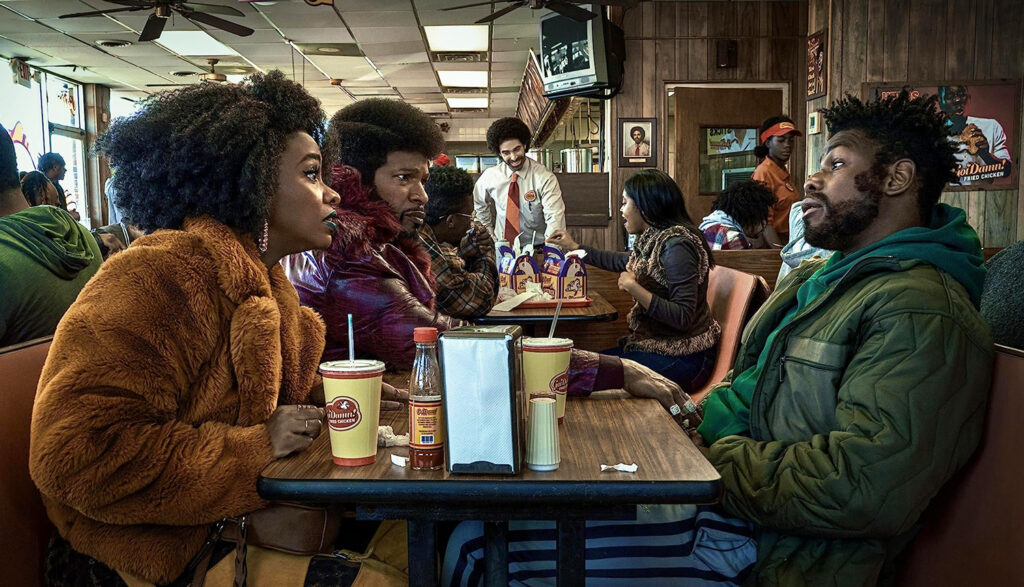
Looking back, maybe Fontaine didn’t need to hit the guy with his car.
But hey, the guy was selling drugs on his turf. What was Fontaine supposed to do, invite the dude over for chili? It’s hard to make a buck in the Glen as it is. Sometimes, when you run a business, you need to run over your competition. When you make an off-the-book omelet, you need to break a few legs.
Still, just inflicting a little bodily injury meant the guy could still limp back to his boss, a rival dealer, and whine about how poorly Fontaine treated him. Fontaine knew the confrontation wouldn’t stop with a snapped femur and a dented hood.
Sure enough.
That night, Fontaine goes to a local motel to collect cash from Slick Charles, a fur-wearing pimp with a nose for cocaine and an eye for self-preservation. Fontaine gets his money. But before he can even pull out of the parking lot, Fontaine’s plugged with a few lead slugs.
And just like that, Fontaine—
Wakes up the next morning, feeling just fine. What a dream, he surely thinks. Only he still has a pizza box full of the previous day’s take. And when he visits Slick Charles again (thinking the pimp still owes him money), Slick looks very surprised to see him.
“You done sold your soul to the devil,” Slick tells him. It’s the only explanation for how a man can get shot in the chest six times one night and be just as ornery the next.
But nope, Fontaine knows there’s another explanation. And he’s determined to find it.
That night, Fontaine, Slick Charles and Yo-Yo, a woman who (ahem) works for Slick some nights, track a mysterious looking SUV to a mysterious-looking house and discover a mysterious-looking elevator inside. Where does it lead? To a mysterious-looking laboratory, of course.
Oh, and they find Fontaine, too. Only he’s dead—six bullets still nestled in his chest.
Weird? Oh, you bet it’s weird. But Yo-Yo’s not deterred. “S— like this always happens to my girl, Nancy Drew,” she says. She’s positive that they’ll uncover a perfectly logical explanation for the lab and the elevator and, y’know, the dead Fontaine.
But Fontaine—the live one—isn’t quite so sure.
Slick Charles isn’t sure he wants to find an explanation, logical or not. He reminds Yo-Yo that they’re not detectives. “You’s a ho,” he tells her. “I’m an entrepreneur,” he adds, euphemistically. And then he points to Fontaine. “And he’s a g-dd–n drug dealer.”
This is all true. The folks we meet here aren’t exactly from society’s top shelf. But (without giving too much away), there are some extenuating circumstances in play. And when it comes to protecting their community and the people in it, the trio proves to be rather resourceful.
Fontaine shows a bit of kindness to others. He invariably makes sandwiches for his mother (which she invariably refuses). He befriends a neighborhood kid. And we can see that he still deeply misses his younger brother, Ronnie, who was apparently killed by a police officer for stealing candy.
As Fontaine, Slick Charles and Yo-Yo try to find out more about that mysterious laboratory—one they believe may be responsible for some experimentation being conducted on the Glen’s unsuspecting residents—an old drunk blearily points them in the right direction.
“Where does everybody go to get answers?” he asks.
“Church?” Yo-Yo says.
“The Big Man will always point the way every time.”
When they get to the church, they see the congregation in a state of near ecstasy (perhaps because of the strange chemicals in the communion grape juice). The preacher preaches “trust” and “obedience” regardless the circumstances (including if a grandchild was gunned down) as a painting of a lily-white Jesus stares down from behind the altar and the congregation dances. (“I ain’t been to church in a while, but something’s up,” Slick says.) Later, when the church is vacant, they find a key-card reader embedded in the altar (the painting of Jesus, the “Big Man,” pointed right at it), which leads to an important secret.
The congregation is compared to Jim Jones’ own cult (right down to the Kool-Aid). When the investigation turns dangerous, Slick Charles wonders why they want to keep opening doors to “sin and iniquity.” We hear references to Babylon and Mount Zion (the church is named after the latter).
As you likely gathered, Yo-Yo is a prostitute. She complains to Slick about a masochistic act that one of her Johns wanted her to participate in, and she has euphemistically named various sexual acts on her “menu” after various celebrities. (She tells one customer that $50 won’t buy him a David Carradine, but it would qualify him for a Susan Sarandon.) Her outfit displays quite a bit of cleavage, and she adjusts her breasts inside that outfit at one point.
She’s not the only woman selling her body. We see others soliciting customers. And in one scene, prostitutes pretend to participate in sex acts with men in cars. (They know they’re being surveilled by nefarious forces, so they’re delivering messages under the pretext of conducting “business.” A scene takes place in a strip hall: Several women are seen from behind in G-string getups and other outfits that display a lot of flesh. (We see quite a bit of skin elsewhere, too, though no breasts or genitals.)
Naked people (men and women) do stalk the streets of Glen at one point, though critical parts are pixelated out. (Most of the footage we see of them is aired on the nightly news.) Other apparently naked bodies float in cylinders in laboratories.
Slick “manages” several sex workers. He offers Fontaine the use of one of his employees in an effort to mitigate Slick’s debt to him. We see a picture of a woman wearing a clearly see-through white shirt. Yo-Yo seduces someone in order to get information; we hear plenty of provocative conversation as the seduction takes place.
When Yo-Yo suggests that their experiences have probably a logical, even boring explanation, she compares the situation to the missionary position. When it becomes clear that the explanation isn’t so rational, Yo-Yo again compares it to a sexual activity—only more deviant.
As mentioned, Fontaine hits someone with his car and breaks his leg. (The body rolls up on the windshield before violently landing on the pavement.) Fontaine’s young passenger, a kid nicknamed Junebug, seems startled at first but keeps sipping on his juice box as if it’s not all that abnormal.
Not long after, Fontaine gets shot in the chest several times. The wounds aren’t particularly bloody, but we do see holes in Fontaine’s sweatshirt and, later, his exposed torso.
We see dead bodies elsewhere. Someone is shot in the chest, leaving a bloody mark in the man’s shirt. Another is eliminated by a bullet to the head (we see the bloody wound briefly). Others are shot and killed, with victims sometimes perforated by bullets.
A man staggers along the street, blood having soaked through his shirt. (The guy is picked up by a mysterious SUV and spirited away.) A character is forced to put a gun he’s holding up to his own head.
A massive violent melee takes place (intending to draw more laughs than blood). People fight with fists and feet. We hear about someone who purposely cut open his genitals. We’re told the awful way in which Fontaine’s brother died.
Are you sitting down?
We’re looking at more than 180 f-words (give or take). More than 120 s-words. More than 70 uses and variations of the n-word. Oh, and the dialogue still leaves room for plenty of other profanities, too, including “a—” (about 50 of those), “b–ch,” “b–tard,” “d–n,” and “h—.” God’s name is misused more than 25 times, and it’s paired with “d–n” all but one of those times. Jesus’ name is abused once. A chain of chicken restaurants contains a twist of “g-dd–n” in its name.
Fontaine, one of the movie’s main protagonists, is, of course, a drug dealer. He seems to specialize in cocaine (he talks with his customers about his merchandise). While we don’t see him using his own wares, he does smoke a lot of marijuana. Every day, it’s suggested, he buys a large beer and pours some of it into an elderly vagrant who hangs out at the convenience store.
Slick Charles does snort quite a bit of Fontaine’s product (explaining his large debt to the dealer). We see him in a hotel room well stocked with liquor bottles. (He mixes a drink shortly before Fontaine bursts in.) In a mysterious laboratory, he discovers a great deal of white powder, which he promptly tries. “It’s not snow,” he says, “But I can still ski in it.”
It becomes quite clear that the substance is not cocaine. It’s one of many substances made that are intended to manipulate the users. Some make folks laugh; others make them angry; still others make them, apparently, compliant.
A scene takes place in a bar/strip club. Several people drink and smoke throughout. A song references “cocaine and ketamine,” along with “a little weed.”
We hear plenty of racial references and slurs, and the movie purposely leans into various racial stereotypes. There’s a short reference to body odor.
We don’t know the entity behind the experimentation going on in the Glen, but it’s clearly big. And if it’s not part of the government, the shadowy organization probably has connections to it. When the trio meets one of its leaders, he characterizes himself as not an agent, but as “mall security—of a really, really big mall.”
If you mixed The X-Files with ’70s Blaxploitation flicks, stirred in some satirical commentary and seasoned it with just a touch of Everything Everywhere All at Once, you might get something like They Cloned Tyrone.
Netflix’s sharp, profane, unhinged comedy offers would-be viewers plenty: Plenty of fine performances. Plenty of absurd humor. And plenty of problems.
Oh, so many problems. By the time the film was 15 minutes old, I’d counted 40 f-words, a handful of drug deals, a couple of prostitutes and one dead body. The movie’s “heroes” clearly work in fields that no college or vocational school would (or legally could) teach. And while that serves the movie’s satirical purpose, that doesn’t mitigate the movie’s avalanche of issues.
The Glen, where They Cloned Tyrone is set, is a fictional neighborhood. When we see license plates, they don’t even name a state: “A Swell Place” is all they say.
But everyone knows that the Glen is anything but swell. Fontaine says so himself. It’s filled with people too poor or stoned or drunk to go anywhere else, and most of its residents would love to leave.
It’s very possible that discernment-minded viewers might have the same reaction to They Cloned Tyrone. Sure, parts of the movie are swell. But other elements might make you want to take the first bus out.


Paul Asay has been part of the Plugged In staff since 2007, watching and reviewing roughly 15 quintillion movies and television shows. He’s written for a number of other publications, too, including Time, The Washington Post and Christianity Today. The author of several books, Paul loves to find spirituality in unexpected places, including popular entertainment, and he loves all things superhero. His vices include James Bond films, Mountain Dew and terrible B-grade movies. He’s married, has two children and a neurotic dog, runs marathons on occasion and hopes to someday own his own tuxedo. Feel free to follow him on Twitter @AsayPaul.